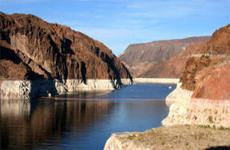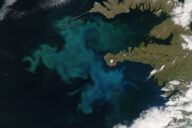Coal-tar sealant is leading source of PAHs in urban lakes, according to USGS
1
Coal-tar based pavement sealant is the leading source of polycyclic aromatic hydrocarbons (PAHs) in 40 urban lakes spanning the nation, according to research from the U.S. Geological Survey published this month.
PAHs are a group of more than 100 chemicals that are produced when coal, oil and gas, garbage, or other organic substances are not burned completely. Several of them are considered probable human carcinogens and pose a threat to aquatic life.
The USGS study, published in the journal Science of the Total Environment, found that runoff from a kind of sealant that is painted onto asphalt to extend its useful life accounted for roughly half of all PAHs in the surveyed lakes. Additionally, vehicle-related sources are responsible for one-quarter, and coal combustion is the third-highest source at around 20 percent, though it varies greatly based on coal use in the area.
USGS scientists collected sediment cores from 40 lakes, analyzed them for PAHs, and determined the contribution of PAHs from different sources using a chemical mass-balance model.
They found that lakes receiving PAHs largely from sealcoat runoff tended to have high concentrations of the toxic substances, enough to threaten aquatic life.
PAH from coal-tar based sealcoat has been on the rise since the 1960s, according to the USGS, but it took researchers decades to determine the source.
In fact, it wasn’t until the 1990s that researchers noticed levels of PAHs were rising significantly in urban lakes.
Finally, in 2005 researchers in Austin, Texas discovered remarkably high amounts of PAHs in drainage ditches, which helped them identify nearby parking lots as the source of the pollution. This survey found that small particles of the sealcoat are worn off by traffic and then carried by stormwater runoff to nearby surface waters. The USGS study aimed to extend this research by gaining a broader survey of PAHs’ impacts and sources.
The three most PAH-contaminated sites from the survey are the Charles River in Boston, Newbridge Pond in New York City, and Upper Mystic Lake in Massachusetts.
Although PAHs are extremely hydrophobic, they settle into the lake-bottom sediment. That means they’re not a hazard to drinking water, but more to bottom-dwelling plants and animals.
The USGS states that PAHs in concentrations higher than 22.8 parts per million of sediment will likely harm bottom-dwelling life. The Upper Mystic Lake, for instance, contained 79.01 ppm of sediment, 55.98 of which came from the sealant.
Responding to earlier research on the toxic substance, Washington, D.C., Austin, Texas, and numerous other areas have banned coal-tar-based sealants, according to The Arlington Advocate, and Home Depot stopped carrying such sealants five years ago. But the sealant is still widely used throughout the nation, according to the USGS, especially in the Midwest, the South, and the East.
New source of pollution discovered in lake that borders Arlington [The Arlington Advocate] Coal Tar Sealant Largest Source of PAHs in Lakes [U.S. Geological Survey]
Image Credit: http://www.flickr.com/photos/articnomad/211169462/














No Change in Amount or Sources of PAHs in Austin, Texas Years After Product Ban
PAH Fingerprints Do Not Identify Pavement Sealants as Source
ALEXANDRIA, Va., Dec. 9, 2010 /PRNewswire-USNewswire/ — More than two years after Austin, TX banned refined tar sealants, there has been no discernable change in either the amount or sources of polycyclic aromatic hydrocarbons in sediment in Austin’s waterways. Austin’s ban went into effect on January 1, 2006.
Results of a study of the ban’s impact were just published in a paper titled Polycyclic Aromatic Hydrocarbons (PAHs) in Austin Sediments After A Ban on Pavement Sealers in Environmental Forensics, the journal of the International Society of Environmental Forensics. Samples were collected from Austin’s streams before the ban, in October 2005, and again after the ban in April 2008. Total concentrations of PAHs in sediments before and after the ban did not change, as might be expected if sealants were the principal source of PAHs in sediments. According to the study’s author, Dr. Robert DeMott, the variation in individual PAHs is expected because PAHs are so common in so many different products. PAHs in the Austin samples were also evaluated using environmental forensics techniques. PAH fingerprinting of sediments collected before and after the ban did not identify any marked changes.
PAHs are everywhere in the environment and are formed by burning organic matter.. PAHs are found in used motor oil, grilled meats and vegetables, exhaust from internal combustion engines and emissions from fossil fuel power plants, forest fires and volcanoes as well as products made from coal and petroleum. The follow-up study of sediments in Austin as well as the results of a PAH fingerprinting study presented at a recent meeting of the Society of Environmental Toxicology and Chemistry (SETAC) indicate that pavement sealants are not the principal source of PAHs in downstream sediments, as has been suggested by others. Both studies were sponsored by the Pavement Coatings Technology Council, which researches and promotes environmentally responsible practices by sealcoat applicators.
http://www.pavementcouncil.org
Link: http://www.prnewswire.com/news-releases/no-change-in-amount-or-sources-of-pahs-in-austin-texas-years-after-product-ban-111587649.html